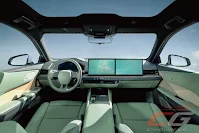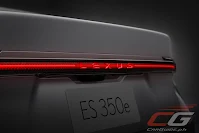Lexus pulls the curtains off the eighth-generation ES featuring a radical new redesign and the addition of a battery electric version.
The mid-sized executive sedan debuts Lexus’s new design direction—Clean Tech x Elegance. The sheet metal is inspired by the LF-ZC concept with its spindle shape that extends from the hood to the bumper corners. The ES gets the new Twin L-Signature Lamps which act as inward-facing DRLs and outward-facing turn signal lamps at the same time. The difference between the hybrid and BEV version is down to the grille with the former receiving a slim upper grille for cooling. The main headlights, meanwhile, are now integrated into the blacked out bumper corners. Over to the side, the overall profile has been sharpened with a fastback-like profile, while the rear-end now has slim full-width taillights and L-Signature lamps in the bumper corners.
Inside, Lexus has designed its all-new ES with the Chinese market in mind. In that regard, they’ve piled up on the tech with a 12.3-inch digital instrument cluster and a widescreen display that house both the 14-inch infotainment and an additional screen on the passenger side. A less screen heavy version is available which ditches the passenger side screen.
Below the center display is a row of controls for the climate control and certain vehicle functions which remain hidden until lit. They may look like capacitive switches, but offer a “click” when pressed for easier operation on the go. Also on offer are an electrochromic panoramic glass roof, a Mark Levinson surround sound system and a reclining rear seat option, the latter featuring a passenger-side ottoman and a one-touch folding front passenger seat to increase rear legroom.
The all-new Lexus ES draws plenty of inspiration from bamboo, including the new light green upholstery option and the 3D-printed layered trim with see-through thematic ambient illumination.
Per Lexus, the all-new ES’s spaciousness has been improved by extending the length by some 165 mm, with the wheelbase also growing by 80 mm.
Built on a redesigned TNGA-K platform (GA-K), the ES is available with two hybrid powerplants. The ES 300h pairs a 2.0 liter naturally-aspirated four-cylinder petrol engine with an electric motor for a total system output of 197 horsepower, with all-wheel-drive versions instead gaining a 2.5-liter for a total of 201 horsepower. Meanwhile, the ES 350h gets an uprated 2.5-liter powertrain with a total output of 247 horsepower.
New to the ES family is a pair of fully electric powertrains. The front-wheel drive ES350e produces 224 horsepower and has a range of around 685 kilometers, while the ES 500e delivers dual-motor all-wheel drive and 343 horsepower, with a slightly shorter range of 610 kilometers.
Handling has been improved thanks to a new rear suspension and further refinements to its body and structure to sharpen its steering and responses.
The Lexus ES is also the first model to gain Lexus Safety System+ 4.0. Among the new features include eco function for the adaptive cruise control, navigation-based curve speed reduction, smoother lane change assist, increased junction support for the autonomous emergency braking, a camera-based driver attention monitor, an emergency stop assist, and high-definition adaptive high beam.


















RZ sedan
ReplyDeleteStill cant believe that this is a real Lexus and not a rebadged Chinese car. Gotta buy a lexus now if this is the future of their interiors, more screen and less buttons.
ReplyDeleteit looks to be trying too hard to be sporty even though it doesn't have to
ReplyDeleteLooks like ES has replaced both the Lexus GS and LS.
ReplyDeleteExciting to see whether buyers will opt for the hybrid or for the battery electric version.
ReplyDelete